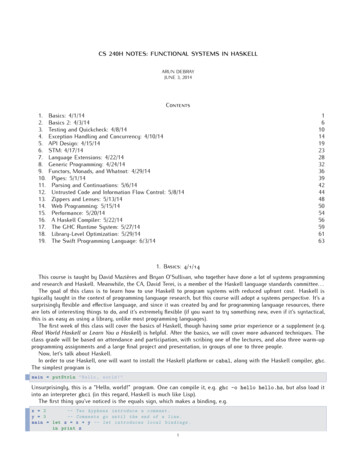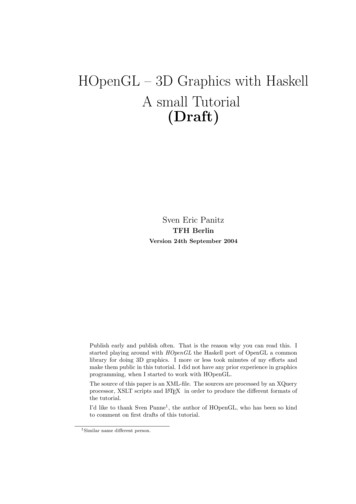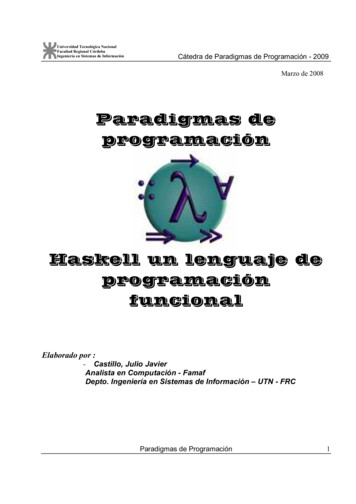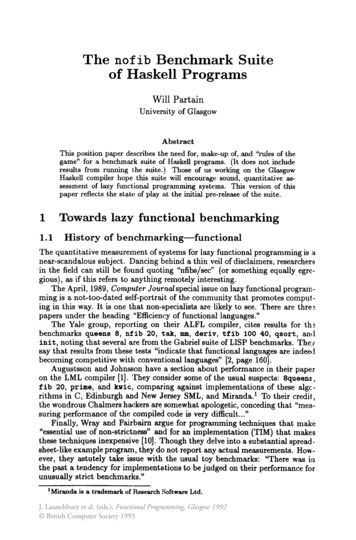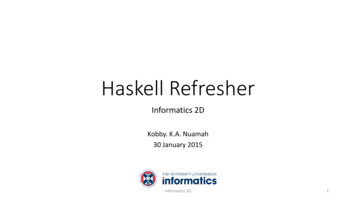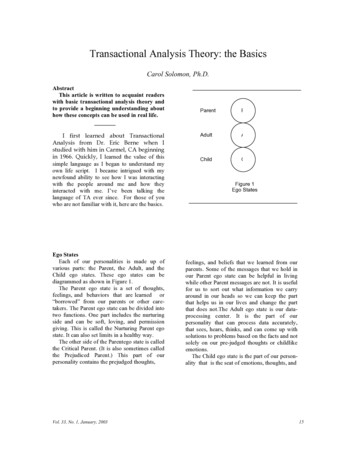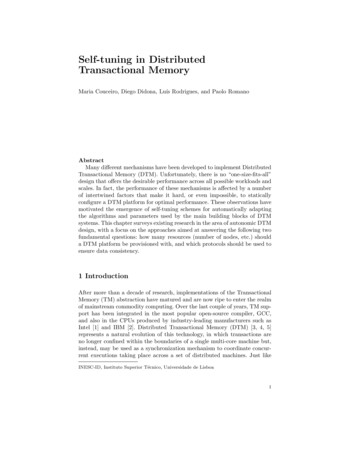
Transcription
Dissecting Transactional Executions in HaskellCristian Perfumo *Nehir Sonmez *Adrian Cristal Osman S. Unsal Mateo Valero *Tim Harris# Barcelona Supercomputing Center,Computer Architecture Department, Universitat Politècnica de Catalunya, Barcelona, Spain#Microsoft Research Cambridge{cristian.perfumo, nehir.sonmez, adrian.cristal, osman.unsal, In this paper, we present a Haskell Transactional Memorybenchmark in order to provide a comprehensive applicationsuite for the use of Software Transactional Memory (STM)researchers. We develop a framework to profile the execution of the benchmark applications and to collect detailedruntime data on their transactional behavior. Using a composite of the collected raw data, we propose new transactional performance metrics. We analyze key statistics relative to critical regions, transactional log-keeping and overalltransactional overhead and accordingly draw conclusions onthe results of our extensive analysis of the set of applications.The results advance our comprehension on different characteristics of applications under the transactional managementof the pure functional programming language, Haskell.Keywords Transactional Memory, Multicores, Haskell,Concurrent Programming, Transactional Benchmarks1.IntroductionResearch on Transactional Memory (TM) has been doneover more than two decades with different flavors, semanticsand implementations [1, 2, 3]. Even if a lot of intuitiveconclusions can be made after observing execution times andspeedup analysis, it might be useful to look deeper insidea transactional application execution to extensively inspectthe most relevant characteristics of TM, such as number ofcommitted transactions, rate of aborts, read and write setsizes.Although it is not absolutely necessary, when a programmer runs her application written under a transactionalparadigm, she might like to know some internal details of theexecution. What is absolutely mandatory is that a researcherknows very well how the engine works, because she is trying to make observations on some results to eventually makesomething faster, better or easier.As hinted above, in the particular case of TransactionalMemory, some questions arise when an application is executed: Does my application suffer from a a high rollback1rate? Is it spending a lot of time in the commit phase? Whatis the overhead that the transactional runtime introduces?How big are the readset and the writeset? Is there any relationship between the number of reads and the readset? Whatabout writes? What is the (transactional) read-to-write ratio?What would be the trend like with more processors? The aimof this work is to profile a set of transactional Haskell applications and to draw conclusions out of the data obtainedfrom monitoring actual applications. In order to accomplishthis, the Haskell Runtime System (RTS) has been modifiedby inserting monitoring probes. Those probes extract application runtime data relevant to the software transactional execution.Another motivation for this work is the dearth of Transactional Memory benchmarks. Although several benchmarkshave been developed for future multi- and many-core ChipMultiprocessors [4, 5, 6], none of the applications in thosebenchmarks use Transactional Memory. Pre-TM era Haskellbenchmarks exist [7], and recently a one-application highlytunable TM benchmark was developed for imperative languages: STMBench7 [8]. No TM benchmark exists forHaskell; an appropiate environment to test new TM ideasgiven its small, simple, and easy-to-modify runtime system.This work addresses this issue.In particular, the contributions of this paper are as follows: A Haskell STM application suite that can be used as abenchmark by the research community is presented. The Haskell runtime system is instrumented to collecttransactional information such as commit and abort rates,as well as their runtime overheads on those applications. Based on the collected raw transactional information,new metrics such as wasted time and useful work are derived, which could be used to characterize STM applications. For example, it is observed that applications canbe classified into subclasses such as low, medium andhigh abort-rate, based on clustering the harvested runtime transactional information. This information could beTRANSACT 2007
used by researchers in future work to test the effectiveness of their STM ideas.The rest of this paper is organized as follows: Section2 gives some background on TM in Haskell, section 3 describes the applications in the suite, section 4 discusses thestatistics obtained from the instrumentation of the runtimesystem and finally section 5 concludes and looks into futurework.2.Background: Transactional Memory inHaskellThe Glasgow Haskell Compiler 6.6 (GHC) [9] provides acompilation and runtime system for Haskell 98 [10], a pure,lazy, functional programming language. The GHC nativelycontains STM functions built into the Concurrent Haskelllibrary [11], providing abstractions for communicating between explicitly-forked threads. As Harris et al. state in theirwork [12], STM can be expressed elegantly in a declarative language, and moreover, Haskell’s type system (particularly the monadic mechanism) forces threads to accessshared variables only inside a transaction. This useful restriction is more likely to be voilated under other programming paradigms, for example, as a result of access to memory locations through the use of pointers.Although the core of the language is very different toother languages like C# or C , the actual STM operationsare used in a simple imperative style and the STM implementation uses the same techniques used in mainstream languages [12]. STM-Haskell has the attractions that (i) theruntime system is small, making it easy to make experimental modifications, (ii) the STM support has been presentfor some time, leading to a number of example applicationsusing transactions; indeed, leading to applications whichhave been written by “ordinary” programmers rather thanby those who built the STM-Haskell implementation.STM provides a safe way of accessing shared variablesbetween concurrently running threads through the use ofmonads [1], having only I/O actions in the IO monad andSTM actions in the STM monad. Programming using distinct STM and I/O actions ensures that only STM actionsand pure computation can be performed within a memorytransaction (which makes it possible to re-execute transactions), whereas only I/O actions and pure computations,and not STM actions can be performed outside a transaction. This guarantees that TVars cannot be modified without the protection of atomically. This kind of protectionis well known as “strong atomicity”[13]. Moreover, in thecontext of Haskell and due to monads, the computations thathave side-effects from the ones that are effect-free are completely separated. Utilizing a purely-declarative language forTM also provides explicit read/writes from/to mutable cells;memory operations that are also performed by functionalcomputations are never tracked by STM unnecessarily, sincethey never need to be rolled back [12].2Running STM Operationsatomically::STM a- IO aretry::STM aorElse::STM a- STM a- STM aTransactional Variable Operationsdata TVar anewTVar::a- STM(TVar a)readTVar::TVar a- STM awriteTVar::TVar a- a- STM()Table 1. Haskell STM OperationsThreads in STM Haskell communicate by reading andwriting transactional variables, or TVars. All STM operations make use of the STM monad, which supports a setof transactional operations, including allocating, readingand writing transactional variables, namely the functionsnewTVar, readTVar and writeTVar, respectively, as it canbe seen on Table 1.Transactions in Haskell are started within the IO monadby means of the atomically construct. When a transactionis finished, it is validated by the runtime system that it wasexecuted on a consistent system state, and that no otherfinished transaction may have modified relevant parts ofthe system state in the meantime [12]. In this case, themodifications of the transaction are committed, otherwise,they are discarded. The Haskell STM runtime maintains alist of accessed transactional variables for each transaction,where all the variables in this list which were written arecalled the “writeset” and all that were read are called the“readset” of the transaction. It is worth noticing that thesetwo sets can (and usually do) overlap.Operationally, atomically takes the tentative updatesand applies them to the TVars involved, making these effectsvisible to other transactions. This method deals with maintaining a per-thread transaction log that records the tentativeaccesses made to TVars. When atomically is invoked, theSTM runtime checks that these accesses are valid and that noconcurrent transaction has committed conflicting updates. Incase the validation turns out to be successful, then the modifications are committed altogether to the heap.3.Analyzed ApplicationsThe transactional analysis contains 13 applications, some ofwhich have been written by people who are not necessarily experts on implementation details of Software Transactional Memory, whereas others have been developed by theauthors of this work who have worked using and modifyingHaskell STM runtime for some time. Both kinds of applications are interesting because the former can show the wayregular programmers (the ultimate target of the whole TMresearch) use Transactional Memory and on the other hand,a programmer with a deep knowledge on TM can explorecorner cases, force specific situations or simply augment thediversity by adding applications that are intended to have avariety of features that are different from the common ones.In the set of applications itemized in Table 2, all the runsare arranged according to the execution environment to fitTRANSACT 2007
SingleIntLLLLUnrDescriptionSimulates two autonomous agents, each moving 100 blocks between non-overlappinglocations (CCHR)A greatest common divisor calculator (CCHR)Finds the first 4000 prime numbers (CCHR)A solver of this famous game (CCHR)An algorithm used to efficiently maintain disjoint sets under union, where sets are represented by trees, the nodes are the elements, and the roots are the representative of the sets(CCHR)A shopping simulation of 200000 purchases performed by as many users as the threads theprogram has. It updates stock and spent money per customer. The information is maintainedusing a library called Transactional Cache [14]A corner-case program that consists of n threads incrementing a shared integer variablefor a total of 200000 times. Therefore, the access to the critical section is serialized in thisapplication because the parallelization of two updates to the same variable is not possibleA family of singly-linked list applications inserting and deleting random numbers. Thereare three list lengths: 10, 100 and 1000Same as LL (above), but using unreadTVar [15], a performance improvement that usesearly release [16], i.e. it lets a transaction forget elements that it has read, causing a smallerreadset, faster commits, but also possible race conditions if it is not used properly# lines1150# le 2. Description of the applications in the benchmark, number of lines of code and atomic blocksexactly one thread per core so that when, for example, fourcores are used, each application spawns exactly four threads.The applications marked with (CCHR) were taken from aConcurrent Constraint Handling Rules implementation [17],where the basic idea is to derive a set of rules and applying them until the most simplified expression possible is obtained. In order to reach the goal, each of these applicationsstores the current list of rules as shared data and accessesthem in a transactional way. For example, the union find algorithm is used to maintain disjoint sets under union efficiently. Sets are represented by trees, where the nodes arethe elements and the roots are the representative of the sets[18]. The UnionFind application provided in the implementation of CCHR simply generates a several disjoint sets ofintegers and combines them all together.Even if the results turn out to be different among CCHRprograms, they all share the same principle of execution:they define a set of rules and based on the inputs they createthe initial rules that are derived until getting the most simplified one. This one is the output of the application. The “active” rules are maintained in a so called “execution stack”.Active rules search for possible matching rules in order andthey become inactive when all matching rules have been executed or the constraint is deleted from the store.In order to allow thread-level paralellism, several “execution stacks” are simultaneously mantained, meaning thatmultiple active constraints can be evaluated at the same time.The applications also balance the workload by moving constraints from one execution stack to another.TCache is a program that uses a library called Transactional Cache [14] as a base. The application included in thebenchmark models a shop with several clients purchasingitems available in stock. The program finalizes when thereare no more items to sell. The multi-threaded versions has asmany buyers as threads in the application and the shop starts3with 200000 for-sale items. Information about the purchasesis also stored in text files.SingleInt is a simple program that updates an integer variable that is shared among the threads. Both SingleInt andTCache are programs that try to perform in parallel a taskthat is inherently sequential. Since they update the sharedstructure (integer and cache respectively) and almost no further computation is carried out, their performance degradesas the number of cores increases due to extremely high contention. This observation is analyzed in depth in the next section.Linked list programs atomically insert and atomicallydelete an element in a shared list. The workload is equallydivided among the threads and always totalizes 200000 operations. Lists of different lengths (10, 100, 1000) were analyzed given that the behaviour is intuitively expected tobe different. Two flavors of linked lists exist in the benchmark: the regular, and the unreadTVar-optimized [15]. Thenext node link of the linked list is implemented as a transactional variable. The regular version collects are many elements in its readset as the elements traversed, whereasthe unreadTVar-optimized version always maintains a fixed,small-sized readset.3.1A first-order runtime analysisBefore starting to examine detailed internal transactional behavior of the applications, it is important to have a globalidea about their execution time and the percentage of thistime that each application spent inside a transaction. Table3 shows how long, in seconds, each program ran for 1, 2, 4and 8 cores versions. Figure 1 plots these values normalizedto the single-core version and so, comparisons among thescalability of different programs are straightforwardly visible. Most of the applications have smaller runtimes as thenumber of threads goes up but there are a few exeptions thatTRANSACT 2007
r100LLUnr1000PrimeSingleIntSudokuTCacheUnionFind1 22.582.642 43.521.784 04.201.178 .700.74Table 3. Execution time (secs) of each applicationare worth analyzing: SingleInt and TCache experience highcontention because the task they perform does not matchthe optimistic approach of most transactional memory systems (including Haskell). These applications were explicitlywritten to conflict and so, the more the conflicts, the morethe rollbacks, the more the re-executed tasks, the more thecache thrashing and the more the spent time. The other twoapplications that suffer from performance degradation areboth versions of linked list (LL and LLUnr), specially with 8cores. The explanation for this phenomenon is that the number of elements in the list is almost the same as the numberof cores, increasing the number of conflicts.Given Amdahl’s Law, if researchers want to propose improvements for STM management, they have to be sure thata substantial amount of the applications’ runtime is spentinside a transaction. For this reason we included Figure 2that shows the percentage of time each application is inside a transaction for all its different core counts. As it canbe seen in this figure, several applications spend a substantial amount of time in running transactions, therefore improvements in the transactional runtime system will nonmarginally reduce the overall execution time.4.Observed StatisticsAll the experiments are run in a four dual-core processorSMP server with Intel Xeon 5000 processors running at3.0 GHz with 4MB L2 cache/processor and 16GB of totalmemory, and all of the reported results are based on theaverage of five executions.The statistics accumulated by the proposed extension tothe runtime system are encapsulated in a function calledreadTStats, which by being invoked retrieves the wholelist of raw statistics shown in Table 4. This function residesin the file that contains all STM functions (STM.c) insidethe Glasgow Haskell Compiler (GHC) 6.6, where the valuesare gathered at different points in the transaction execution,i.e. when starting the transaction, while performing a read orwrite, or while committing. For some values, the data mustbe temporarily kept in the Transactional Record (TRec), so4new fields were added to the TRec structure. Although thisprocedure does add some overhead on the transactions, it isthe unique way of achieving our objective in this context.Information about timing is obtained by querying hardwareperformance counters. The update of collected statistics isdone at the commit phase and the data relative to transactionsthat were actually committed or rolled back are accumulateddepending on the result of the commit attempt.Out of these values we derive other meaningful statisticssuch as reads per writes, average commit time, average worktime, commit phase overhead and “wasted work”, whichis the ratio of the aborted work to the total work. Notethat these derived statistics such as wasted work could beused as metrics to gauge the transactional performance ofapplications using STM.In our experiments, the total STM execution time (thetime spent executing inside an atomic block) is divided intotwo: the time spent for doing the work the transaction is supposed to do (including the transaction start and the transactional book-keeping), and the commit phase itself, whichsignifies the time taken for committing or discarding the tentative changes. The start transaction phase, which is alwaysconstant and negligable independently of the characteristicsof the transaction, has been omitted from our calculations.Since Transactional Memory is a scheme that imposes thecommitting or rolling back of transaction sequences, the firstissue while trying to monitor the transactional managementis naturally the rate of rollbacks. Later in this work, othervalues will be observed, such as the commit phase overhead,data related to the transactional record, and the percentageof wasted work.4.1Abort RateTo start off, it is important to state that throughout thiswork, the terms abort and rollback are used interchangably.However, the reader should be aware that in other contextsthey might be used to mean distinct concepts.In our set of applications, none of the programs roll backon a single core environment because of the condition previously explained: one and only one thread per core. After analyzing the abort rate (shown in Figure 3) in a multicore environment, a classification was made based on the observedvalues: High abort rate group: In this first group of applicationsreside the SingleInt and the TCache. These programscontinuously update their shared data, therefore abortmost of the time on multicore and also suffer from highcache thrashing. Medium abort rate group: LL10, LL100, LL1000 andLLunr10 abort frequently. For the particular case of aten element linked list, the high rate of rollbacks shouldbe expected even when unreadTVar is used, due to thesmall list size almost ending up equaling the number ofcores present. Even for larger lists, the significantly largerTRANSACT 2007
Figure 1. Execution time normalized to the single-core timeFigure 2. Percentage of the time the application is inside and outside a transactionnumber of aborts is a general case for linked structuressince the STM tries to look after more than what isneeded by collecting all traversed elements in the readset[15]. Low abort rate group: LLunr100 and GCD rarely abort,Blockworld, Sudoku, Prime, LLunr1000 almost neverabort and UnionFind never aborts. The low rollback rateof LLunr100 and LLunr1000 is a consequence of the efficiency of unreadTVar. In general, CCHR applicationsdo not rollback very often, and instead make use of theatomicity promise due to the fact that CHR naturally supports concurrent programming, and wants to make use ofthe simplicity of using transacted channels while doingso [17].It would also be interesting to look at how the abortsare distributed. For this purpose, the histograms in Figure4 show the distribution of rollbacks per transaction from 0to 10 times. It can be clearly seen that the transactions ofthe programs tend to be able to commit mostly in the firsttry, except for the cases of TCache, SingleInt and the LL10.It should also be apparent to see how late some transactionsfinally end up committing, from the last bar of each combination of application and number of cores. Our findingsshow that for some applications certain transactions abortrepeatedly sometimes more than 10 times, which shows the5need for research into STM runtime mechanisms to avoidexcessively aborting transactions for the sake of fairness.4.2Work time, commit time and commit phaseoverheadHaving had a general idea on the set of programs, one cannow proceed to examine another important measure of transactional behaviour, the commit time and the associated overhead.Figure 5 illustrates the way that time is spent when theapplication is within a transaction, taking into account onlycommitted transactions. The values are normalized to thesingle core execution for each application. That is, howmuch of the time is used to execute the transaction and howmuch to commit it. The commit phase overhead is obtainedby dividing the commit phase time by the total time. We believe that commit phase overhead could be one of the appropriate metrics to measure STM implementation performance. The highest commit phase overhead per committed transaction is present in the programs belonging to theCCHR set: reaching almost 70% in the case of UnionFindrunning on two cores (GCD is an exception with no morethan 24%). For scalability, these applications have a verylarge number of small transactions to avoid costly rollbacksproduced by large transactions, impacting the overall performance negatively.TRANSACT 2007
Figure 3. Rollback rate: Number of rollbacks per committed ogramOfRollbacksExplanationAccumulated time the application spent in thecommit phase (transactions that have finallycommitted)Number of committed transactionsTotal number of transactional reads in committed transactionsSum of the readset sizes of all committedtransactionsTotal number of transactional writes in committed transactionsSum of the writeset sizes of all committedtransactionsAccumulated time that the application spentinside a transaction that finally committed(useful transactional work)Accumulated time the application spent in thecommit phase (transactions that rolled backin the end)Number of rolled back transactionsTotal number of transactional reads in rolledback transactionsSum of the readset sizes of all rolled backtransactionsTotal number of transactional writes in rolledback transactionsSum of the writeset sizes of all rolled backtransactionsAccumulated time that the application spentinside a transaction that finally aborted(wasted transactional work)Number of transactions that were rolledback0 . 10 times and more than 10 timesTable 4. Summary of the statistics gathered by readTStatsRegarding high abort-rate applications , SingleInt (beingsecond highest) had on average 25,1% commit overhead percommitted transaction, while TCache only had 3,4%. Theexplanation for such a big difference between these twoapplications that belong to the same group is that for thesingle integer application, the only work that has to be doneis to read and write back a variable, whereas in the latter, therelatively larger work involves finding the item, the user, andcalculating and updating the stock values.For the linked list programs, larger list size implies lesscommit overhead because although there is a larger read6set and writeset and a greater number of reads in these programs, the commit time does not rise as rapidly as the worktime, as the list size goes up.Another observation is that when the number of coresincreases, the number of aborts usually increases as well,except for BlockWorld and UnionFind that almost neverabort (i.e. they abort either zero or once). Having more abortswhen the number of cores (and then threads) goes up is dueto the situation of having more concurrency and parallelismin the application. This increases the probability of conflictand, therefore, rollback.A last interesting point is that average time per commitincreases as number of cores goes up. Especially the biggestjump is observed when going from 1 to 2 cores, with a 2-4xincrease. Although this needs further investigation, a sensible explanation for this is that shared variables are morelikely to be spread among local caches of all the cores, andtherefore, the situation mentioned above might be due tocache misses. Although architectural concerns are beyondthe scope of this paper, this is an incidence where the architecture of the system affects the calculations. For aborts,there is only a slight increase in commit overhead becauseall that has to be done is to nullify local (i.e. speculative)changes.4.3Readset, writeset, reads, writes and reads/writesFirstly, it should be pointed out that on committed transactions, the number of reads per transaction is constant for almost all programs regardless of the number of cores, sincethe readset and the writeset is usually defined by the program itself and not the transactional management (Figure6). A subtlety to clarify is the issue with expressing the sizeof the readset and the writes. It is very common for thesetwo sets to intersect, for which we have accounted for inside the writeset, rather than the readset. So our readset measurements only include those transactional variables that arestrictly only read.In terms of efficiency regarding the writes, the optimalcase is that the writeset equals the number of writes performed because the transactions only persist their changesby committing, and thus there would be no point in writingTRANSACT 2007
Figure 4. Rollback histograms7TRANSACT 2007
Figure 5. Commit phase overhead (Normalized to single core time)Figure 6. Number of reads and size of the readset on committed transactionsa transactional variable more than once. Figure 7 comparesnumber of writes to writeset size, showing that programmersusually use transactional writes efficiently. In case the STMprogrammer needs to change a value several times withina transaction, she can always do it with other kind of variables rather than with the Haskell transactional variable TVar(ones with cheaper access, because STM writes imply identifying a variable in the writeset and only after that updatingthe local copy) and then have the final result in the writesetto be committed. This optimization could also be performedby the compiler.In the case of the linked list (with and without unreadTVar) on commits, while the number of writes is constantfor all list sizes, the reads increment about 10 times as listlength is increased by an order of magnitude, which shouldbe obvious because traversing a ten times bigger list leads toreading ten times more nodes on average.unreadTVar functionality causes a very small commitreadset (with no other changes whatsoever in reads/wri-8tes/writeset) and for aborted transactions it presents verysmall numbers for all values of reads, writes, readset, andthe writeset. As it is explained in [15], the proper use of unreadTVar on the linked list binds the readset of an insertionor a deletion to a maximum of three transactional variables,and as seen on Figure 6, the readset size is contant and independent of the list size, whereas regular linked lists havereadset sizes proportional to their length.For the aborted linked list transactions (not shown), it wasobserved that all these four statistical values significantly decrease as more cores are introduced. This suggests that sincethere are less transactional variables to check for, aborts areless costly with more cores, at least for the commit phase.However the wasted work is still wasted and is usually increasing with more cores.Another interesting observation concerns the relation between the readset size and the rollback probability of transactions. In the case of Haskell STM, a transaction T1 will berolled back if and only if some other transaction Ti has modi-TRANSACT 2007
Figure 7. Number of writes and size of the writeset on committed transact
Haskell The Glasgow Haskell Compiler 6.6 (GHC) [9] provides a compilation and runtime system for Haskell 98 [10], a pure, lazy, functional programming language. The GHC natively contains STM functions built into the Concurrent Haskell library [11], providing abstractions for communicating be-tween explicitly-forked threads.As Harriset al.state .


